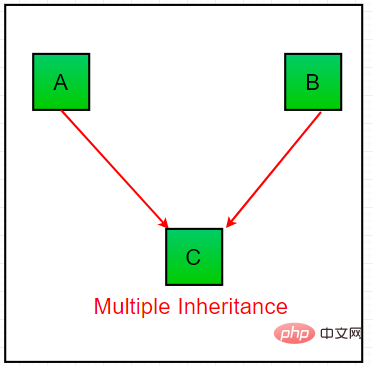
This article brings you an introduction to what inheritance is in Java? How to implement inheritance. It has certain reference value. Friends in need can refer to it. I hope it will be helpful to you.
What is inheritance in java?
Inheritance in Java is a mechanism by which an object obtains all properties and behaviors of its parent object. It is an important part of object-oriented programming system (OOP).
The idea of inheritance in Java is to create new classes based on existing classes. Inheriting from an existing class allows you to reuse methods and fields of the parent class. Additionally, new methods and fields can be added to the current class. [Related video tutorial recommendations: JavaTutorial]
Inheritance represents the IS-A relationship, also known as the parent-child relationship.
Terms used in inheritance
1. Class: A class is a group of objects with common attributes. It is a template or blueprint for creating objects.
2. Subclass: A subclass is a class that inherits other classes. It is also called a derived class, extended class or subclass.
3. Super class/parent class: Super class is a class from which subclasses inherit functions. It is also called base class or parent class.
4. Reusability: As the name specifies, reusability is a mechanism that helps you reuse the fields and methods of an existing class when creating a new class. You can use the same fields and methods that were defined in the previous lesson.
Why use inheritance in java?
1. Method rewriting can be achieved (this can achieve runtime polymorphism).
2. Inheritance allows us to reuse code, which improves the reusability of Java applications.
The implementation of Java inheritance
The basic syntax of Java inheritance
To inherit a class, We use the extends keyword. Class XYZ here is a subclass, and class ABC is a parent class. Class XYZ inherits the properties and methods of class ABC.
class Subclass-name extends Superclass-name
{
//方法和字段
}extends keyword indicates that we are creating a new class derived from an existing class. The meaning of "extends" is to increase functionality.
In Java terminology, the inherited class is called the parent class or super class, and the new class is called a subclass.
Inheritance example:
In the following inheritance example, class Bicycle is a base class, class MountainBike is a derived class, which extends the Bicycle class, and class Test is a driver class that runs the program.
//用java程序来说明
// 继承的概念
// 基类
class Bicycle
{
// Bicycle类有两个字段
public int gear;
public int speed;
// Bicycle类有一个构造函数
public Bicycle(int gear, int speed)
{
this.gear = gear;
this.speed = speed;
}
// Bicycle类 有三种方法
public void applyBrake(int decrement)
{
speed -= decrement;
}
public void speedUp(int increment)
{
speed += increment;
}
// toString()方法来输出 Bicycle类信息
public String toString()
{
return("没有的齿轮个数是 "+gear
+"\n"
+ "自行车的速度是"+speed);
}
}
// 派生类
class MountainBike extends Bicycle
{
// MountainBike子类增加一个字段
public int seatHeight;
// MountainBike子类 有一种构造函数
public MountainBike(int gear,int speed,
int startHeight)
{
// 调用基类(Bicycle类)构造函数
super(gear, speed);
seatHeight = startHeight;
}
// MountainBike子类增加一个方法
public void setHeight(int newValue)
{
seatHeight = newValue;
}
// 重写toString()方法
// 输出跟多Bicycle类信息
@Override
public String toString()
{
return (super.toString()+
"\n 座位高度为 "+seatHeight);
}
}
// 驱动程序类
public class Test
{
public static void main(String args[])
{
MountainBike mb = new MountainBike(3, 100, 25);
System.out.println(mb.toString());
}
}Output:

Inherited types in Java
In the class Basically, there can be three types of inheritance in Java: single, multi-level and hierarchical.
1. Single inheritance: In single inheritance, a subclass inherits the characteristics of a superclass. In the diagram below, class A acts as a base class from which class B is derived.
2. Multi-level inheritance: In multi-level inheritance, the derived class will inherit the base class, and the derived class will also serve as the base class for other classes. . In the image below, class A is used as a base class for derived class B, which in turn is used as a base class for derived class C. In Java, a class cannot directly access members of its grandparents.
3. Hierarchical inheritance: In hierarchical inheritance, a class acts as a superclass (base class) for multiple subclasses. In the image below, class A acts as a base class from which classes B, C and D are derived.
4. Multiple inheritance (through interface) : In multiple inheritance, a class can have multiple superclasses and inherit from all parent classes. Function. Please note that Java does not support multiple inheritance and classes. In java, we can only achieve multiple inheritance through Interfaces. In the image below, class C comes from interfaces A and B.

5. Mixed inheritance (through interface) : It is a mixture of two or more of the above types of inheritance. Since Java does not support multiple inheritance using classes, classes cannot implement mixed inheritance. In java, we can only achieve mixed inheritance through Interfaces.
Summary: The above is the entire content of this article, I hope it will be helpful to everyone's study.
The above is the detailed content of What is inheritance in java? How to implement inheritance. For more information, please follow other related articles on the PHP Chinese website!



